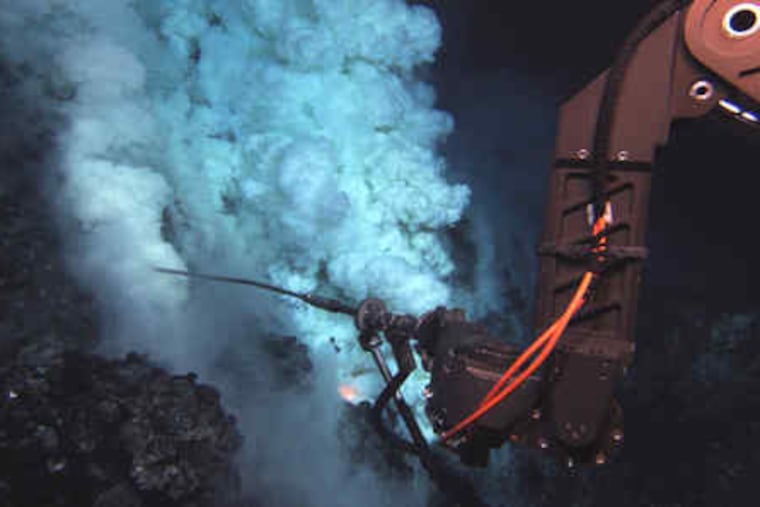Deep eruption caught on video
The volcano spewed 4,000 feet beneath the Pacific. Data may yield clues to Earth's crust.

SAN FRANCISCO - Scientists have recorded the deepest erupting undersea volcano ever seen, capturing for the first time video of fiery molten lava bubbles exploding 4,000 feet beneath the Pacific Ocean.
A submersible robot witnessed the eruption in May during an underwater expedition near Samoa, and the high-definition videos were presented yesterday at a geophysics conference in San Francisco.
Scientists hope the images, data, and samples obtained during the mission will shed new light on how Earth's crust was formed.
The research could also help explain how some sea creatures survive and thrive in extreme environments and how Earth behaves when tectonic plates collide.
"It was an underwater Fourth of July," said Bob Embley, a marine geologist for the National Oceanic and Atmospheric Administration, in a news release. "Since the water pressure at that depth suppresses the violence of the volcano's explosions, we could get the underwater robot within feet of the active eruption."
The eruption was a spectacular sight: Bright-red lava bubbles shot out of the volcano, releasing a smoke-like cloud of sulfur. The lava froze almost instantly as it hit the cold seawater, causing black rock to sink to the sea floor. The submersible hovered near the blasts, its robotic arm reaching into the lava to collect samples.
Earth and ocean scientists said the eruption allowed them to see for the first time the creation of a material called boninite, which had previously been found only in samples at least a million years old.
In the past, boninite lavas had only been found on extinct volcanoes, so researchers were excited to see firsthand how they are created.
The mission to record a deep-sea volcanic eruption was 25 years in the making. Although 80 percent of Earth's volcanic activity occurs in the sea, scientists from NOAA and the National Science Foundation had never witnessed an eruption this deep and in this detail.
The mission's chief scientist, Joseph Resing, last year detected volcanic material in the water near the West Mata volcano, about 140 miles southwest of Samoa. In May, researchers came with a submersible robot called Jason.
"When we got there, we put the sub down, and within in an hour and a half we found an eruption there in its full glory," said Resing, who is a chemical oceanographer at the University of Washington. "We haven't seen this before. And now for the very first time, we see molten lava flowing on the sea floor."
Scientists said the water around the volcano was more acidic than battery acid, but shrimp and certain microbes were able to thrive. Biologists were also excited about a new opportunity to study the creatures to see if they are unique to this volcanic environment.
Tim Shank, a biologist at the Woods Hole Oceanographic Institution in Massachusetts, said the deep-sea eruption will help researchers study how life survives in an extreme underwater environment.
"Deep-sea biologists are obsessed with determining the rate of processes, how fast something happens. The anticipation here is if this ground remains unstable because of lava pushing out and breaking away, it will not provide a surface area for these organisms to colonize," he said.